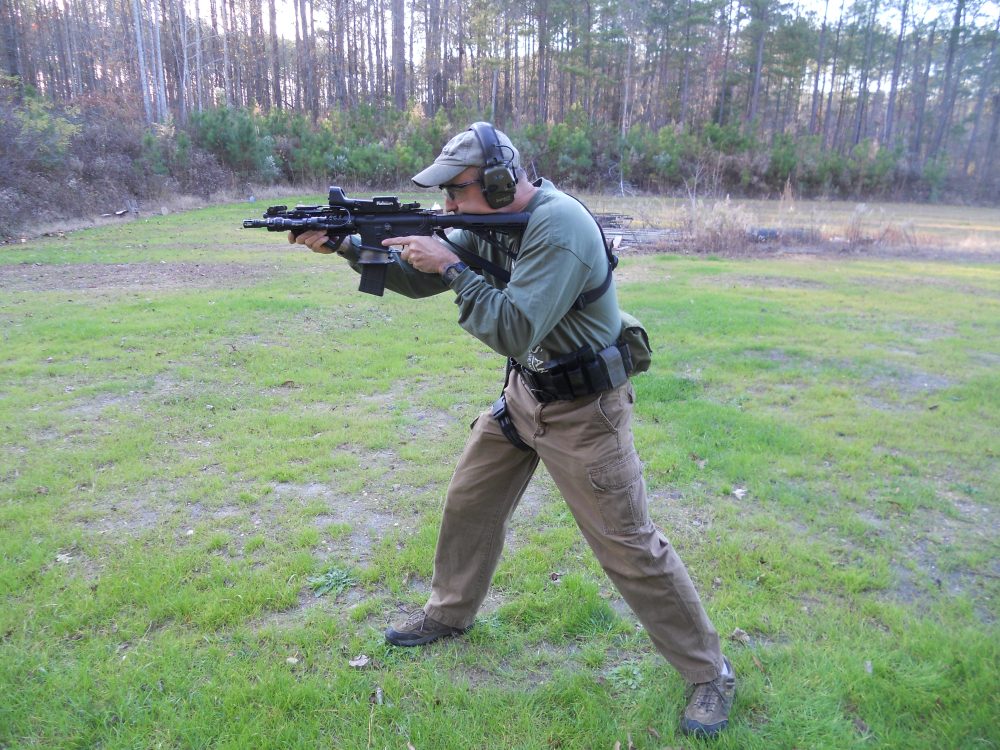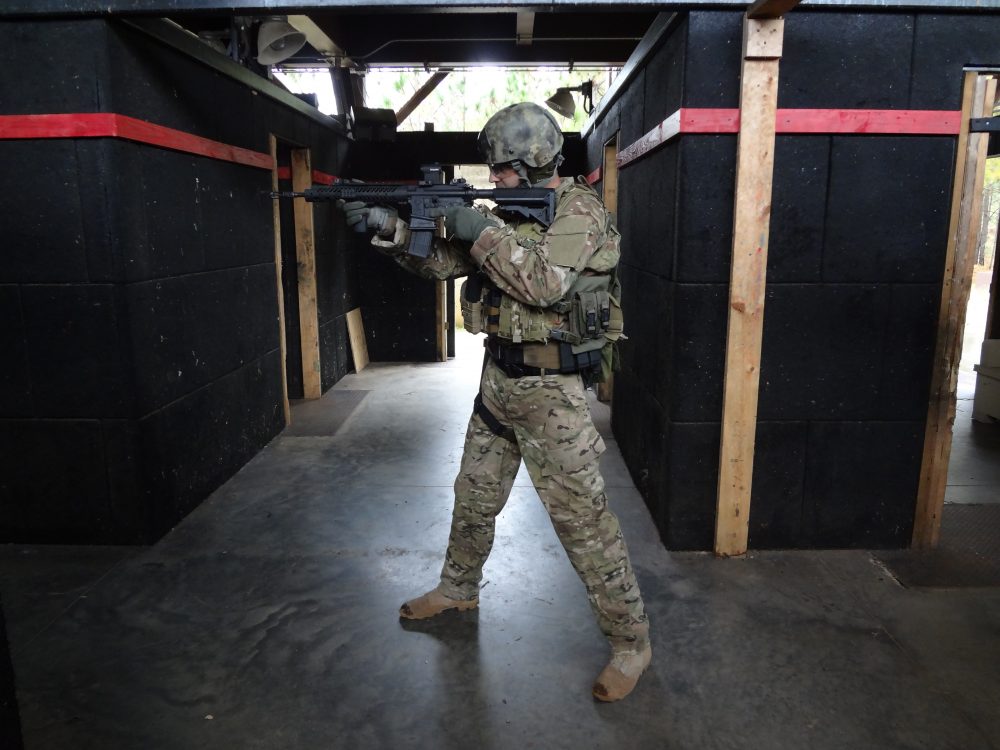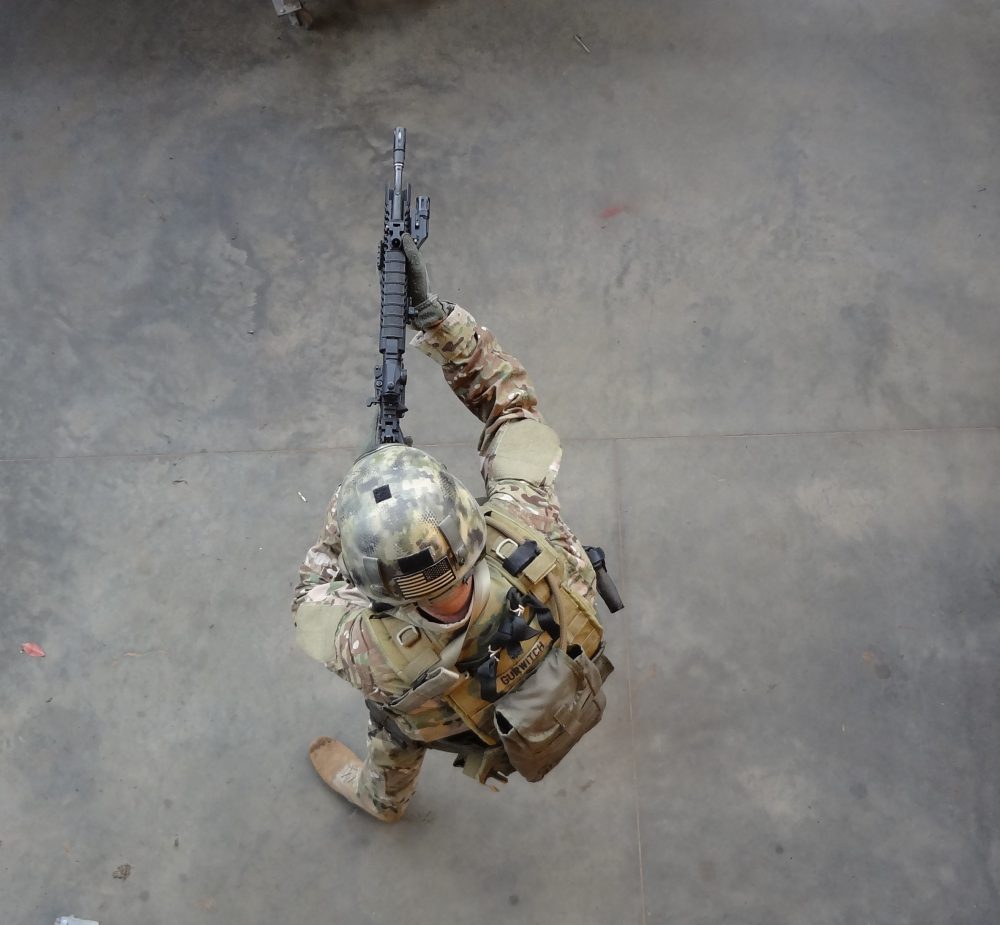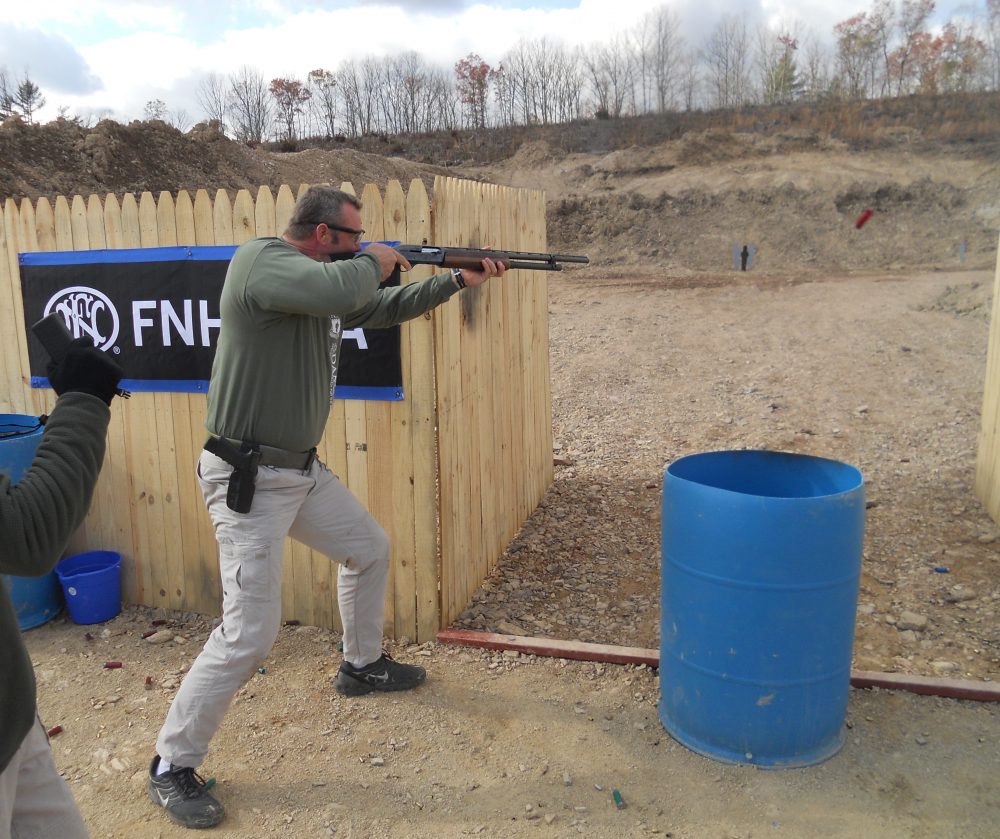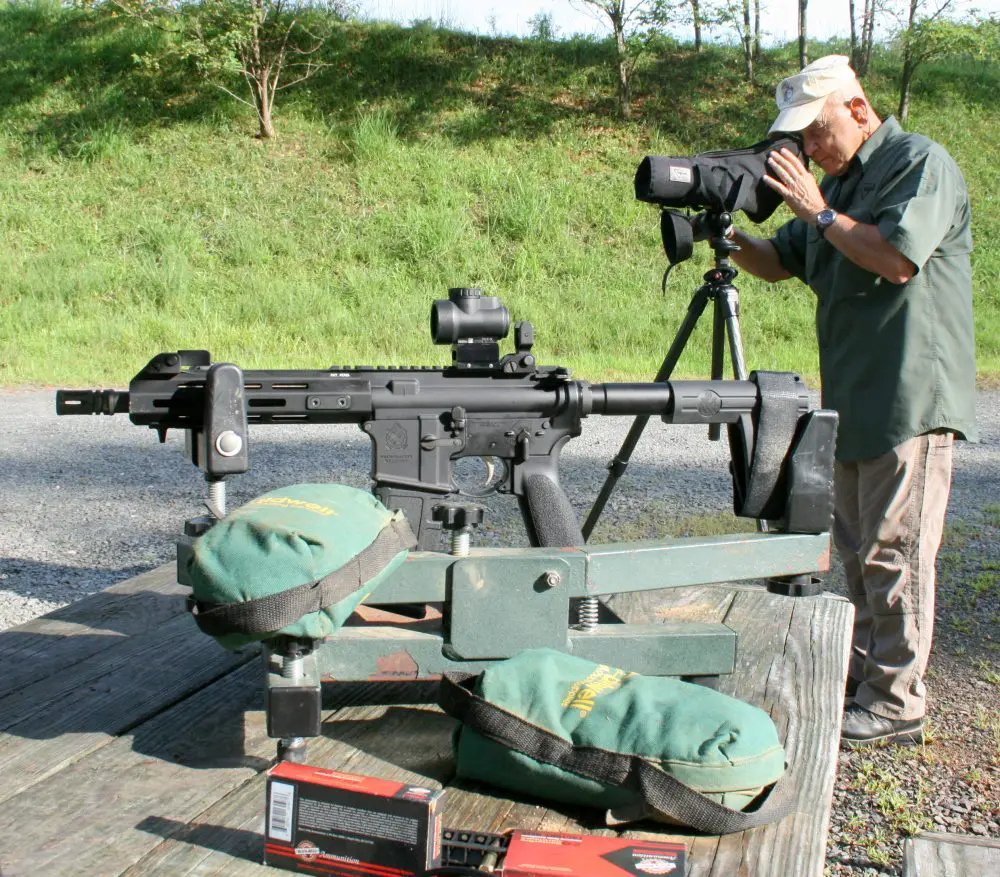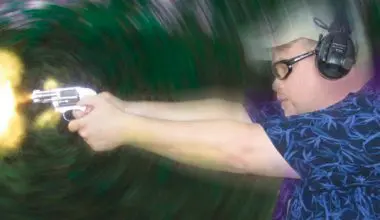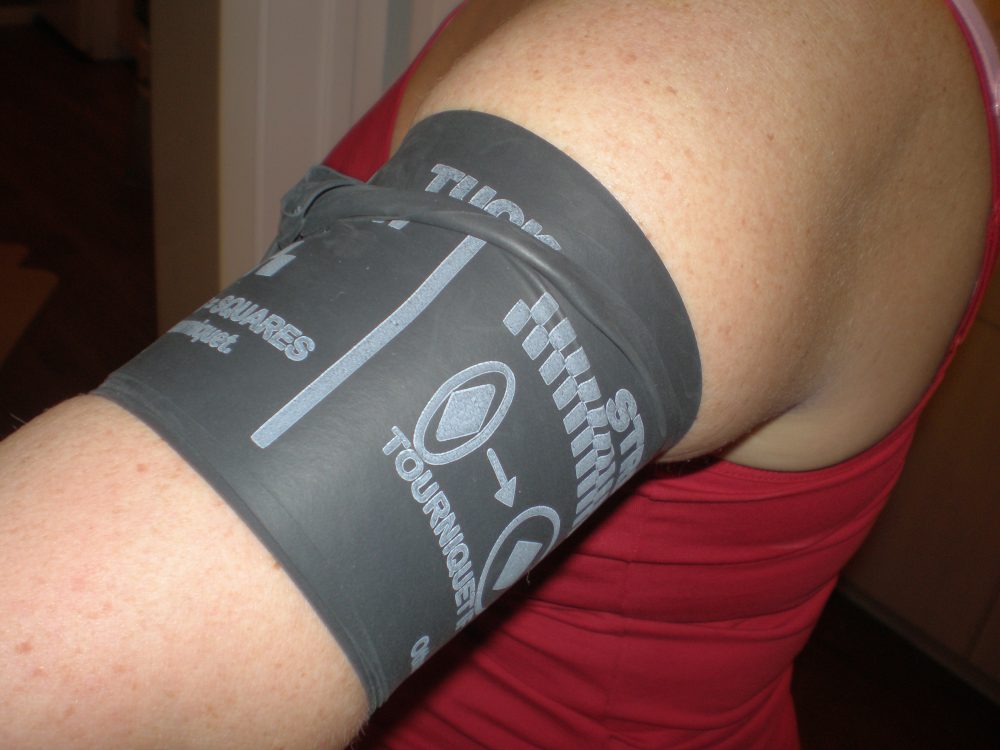A common mistake among shooters who are new to either tactical or competitive shooting with an AR-type rifle is improper stance. The issue: people who learned to shoot a pistol first usually try to use the same stance with a rifle, and while you can get shots off with reasonable speed and accuracy, you are standing too narrowly to reach your full shooting ability.
If you ask a shooter to take up a fighting stance with their AR or long gun, more often than not it looks more like a classic Weaver or Modern Isosceles rather than a true fighting stance.
The classic technique of feet shoulder width apart and non-firing leg slightly forward is a good basic stance that works great with shooting pistols and is a decent method for learning the basics of shooting from.
This stance, however, is generally too narrow to support both the increased recoil from rifles and shotguns and tactically it is too narrow a stance to fight from.
Fighting rifle stance.
Table of Contents
TRUE FIGHTING STANCE
The solution? I advocate using what I call a true fighting stance, one that allows for shots from a stationary position but also sets you up to launch into dynamic movement if necessary, such as sprinting to cover or shooting on the move.
It is also a stance that facilitates transitioning to any type of firearm with no change in your footwork. The last thing you want to do while transitioning from one firearm to another is shuffle your feet around at the same time you’re trying to pick up your sights and acquire your target. It can cost you time in a match and in real life allow your target to move on you or worse, get their shot off first.
I use the term true fighting stance to describe how to position your body to hold a firearm—particularly a long gun—for any type of scenario, whether it’s defensive, tactical, or competition like three-gun.
Use one basic stance for all. Because the demands on you as the shooter are the same, you might need to make super-fast shots at single or multiple targets, or low-percentage shots, meaning a minimum amount of the target is exposed (such as behind cover).
The target could also be among bystanders, or no-shoots that you have to take into consideration and shoot around.
Author uses classic “feet shoulder width apart” stance. While he can take shots standing like this, he’s not set up to run and drive the gun to his maximum ability.
GETTING INTO POSITION
To take up the fighting stance, extend your non-firing leg double the distance of a normal shooting stance. Your back should be slightly bent forward so your shoulders are just over your hips in the front by about an inch, and shoulders generally squared up to the target.
By doubling the distance of your non-firing leg, it will give you a slight natural blading in your shoulders to your support hand. It also drops your center of gravity down lower and helps put you more behind the weapon regardless of which type of firearm you are shooting, allowing you to shoot faster strings of fire by being more planted in behind the rifle.
While the classic “feet comfortable distance apart” stance will work for pistol shooting, when most people pick up a rifle or shotgun, they end up widening their stance to accommodate the recoil. By starting out in a wide aggressive stance, you can go from rifle to pistol or vice versa without having to move your feet at all. There is no wasted time adjusting your feet to the type of weapon.
Keeping your shoulders generally squared to the front allows for a better pocket for the buttstock of the rifle to sit in, which in turn will help you drive the gun better. You see a lot of shooters do the opposite. Especially for long-range standing shots, they overexaggerate and blade out, trying to use skeletal support to lock out.
Author has his non-firing leg out double the distance, with slight bend at the waist. This gives him a steady base, naturally aligns his shoulders behind the rifle, and absorbs recoil better to drive the gun on target.
While this may be fine for slow fire or a single long-range shot, as soon as you increase your cadence, you will find the rifle wanting to slip off from not having enough shoulder behind for the buttstock to rest against.
To hold the rifle in place, you end up having to use muscle tension to keep the rifle steady. After a second or two, this will start to work against you. Keeping your shoulders square offers a good natural pocket that creates a solid base to pull the rifle back into.
Combining this with a C-clamp style grip on the forearm will greatly enhance your ability to redirect the felt recoil. Instead of an up-and-down motion off the muzzle, you get a straighter push-back during recoil into your body. Cutting down or redirecting felt recoil allows the rifle to settle faster between shots, which allows you to put out faster strings of fire.
Regardless if it’s a three-gun competition…
…or a tactical situation, the demands on the shooter are the same. With a deep aggressive fighting stance, you are set up to fire the fastest, most accurate shots possible.
WHAT TO LOOK FOR
One of the easiest indicators to determine if your stance is too narrow and not aggressive enough is to look at what happens to your toes while firing. If you notice the tips of your shoes lifting off the ground with each shot, your stance is too narrow. While shooting, adjust your non-firing leg straight out until both feet no longer lift up.
Another basic test is a partner resistance test. Take up your normal shooting stance, extend your arms, and place both hands together like you are holding a pistol. Then have someone push against your hands with just their body weight. If you get pushed back, your stance is too narrow and you want to open it up. Again, feet should be shoulder width apart, but extend the weak side leg out to where the force pushed against does not push you back off your feet.
Just ensure you do not resist the force being applied by leaning forward to compensate against the pressure. Bearing down and leaning into it to counter recoil—or in this case your partner’s force—requires muscle tension. Just like with too much grip force while shooting, if you apply muscle tension to hold steady, it might work for a second or two, but after awhile you will start to shake and that will affect accuracy.
Additionally, if you are wearing body armor, this is the last thing you want to do. It will put the weight of your body armor in front of your hips and strain your back. Yes, you can pull off a few strings of fire like this, but again you’re setting yourself up for failure if you’re going to shoot sustained strings of fire or long-range standing shots. The strain on your back will affect your ability to hold the rifle steady.
This shooter is running bladed in an attempt to minimize exposure. From this angle, it’s obvious the benefit of running bladed—even from a threat directly to the front—is minimal. If engaged from any other angle, there is no benefit at all. It’s better to run in an offensive stance that facilitates your shooting to the best of your ability!
ADJUSTMENTS
Using the same aggressive fighting stance, you are now set up to be braced for super-fast splits at close range and settled behind your gun for medium-and long-range standing shots.
There are only two minor adjustments I sometimes make, depending on what type of engagement is needed. The adjustments occur only in the shoulders and support arm. Foot placement stays the same.
When I need to shoot very fast strings of fire (five or more shots at one time), I roll my firing shoulder forward a bit more, putting it even more behind the buttstock and creating a deeper pocket and a little extra behind the rifle. This maximizes my ability to settle the rifle between shots to really crank off the fastest strings I am able to hammer out on target.
The other small adjustment I sometimes make is for long shots. I rotate just slightly and blade out my non-firing shoulder and arm about an inch more toward the target. This feels a little more relaxed—and being more relaxed equals a steadier shot.
Mike Duskin uses fighting stance in competition. Even though Mike is 6’ 7” tall, weighs 270 pounds and has no trouble manhandling the shotgun on target, he still takes the extra fraction of a second to get deep into a fighting stance. This results in an increased ability to settle the gun faster between shots. Less overall time engaging targets means a better score for that stage.
TACTICAL SHOOTING
Whether shooting slick or in full kit (body armor and helmet), the stance stays the same. Besides using too narrow of a stance, another mistake you see a lot in the tactical world is shooters who, instead of getting aggressive in their footwork, bend forward at the waist and lean into the rifle to control the recoil.
This will work for shooting slick, but once you throw on the added weight of body armor, you will soon find yourself fatiguing your lower back as you keep the weight of your body armor forward over your hips. With body armor, I don’t change anything by utilizing a wide stance. I’m already set up to manage recoil, and the extra weight of the armor is evenly distributed straight down both legs.
This type of fighting stance would be considered a “plate to the front” in terms of shooting technique. The term “plate to the front” originated with tactical entry teams and CQB. As a member of an assault team, you have to make entry into rooms against armed threats. Your only defenses are speed and surprise, your offense is lethal fire, and your only cover is your own body armor.
I know running plate to the front or going bladed to present a smaller target are hot topics among shooters. I prefer to think offensively, so I will always go with a technique that best facilitates my shooting.
Another reason I concentrate on my ability to run a gun and not how I present to a target is that in a gunfight—even at room distance—you can be engaged from any angle. Blading out to one side will cut your exposure to a target straight in front of you, but a hostile just off to the side—as little as 20 or so degrees—will have a very large part of you to engage.

VARIABLES
The only variables I take into consideration in regard to changing my fighting stance are if I am a lone shooter or shooting as a member of a tactical team.
As a member of a tactical team, you might have to sacrifice your optimal stance or way of walking in order to remain tight within the stack. One of the key things a tactical team must do is move as one and flood a room. If they are stacked up tight enough and move with speed, a four- or five-man stack can flow into a room and all be in position to bring fire almost at the same time on any threats in a room.
To do this, you must keep pace with the number one man. If he is taking short steps, you must match his to remain tight. If you try to keep extra-wide steps so you can move into an aggressive stance once you enter the room, it will create a gap as you walk. So the guy in front of you will be exposed to the angle you are supposed to pick up just that much longer.
If you get a chance to observe or train with a tactical entry team, you’ll find it’s easy to distinguish less trained or experienced members by the sound of their gunfire as they enter a room.
With a trained team stacked up tight, as soon as you hear the first guy start to fire, an immediate wall of fire commences—that’s all the team members following in within fractions of a second and firing almost at once. With a less experienced team, you will hear one guy fire, then a second, then a third, and so on. The gaps in the stack delay the members entering, so you can hear them come in one by one and start firing.
COMPETITION SHOOTING
In most competitive pistol sports, the winner is usually the one with the fastest shots on target and who runs a course of fire in the least amount of time.
In pistol-only matches—when wins come down to tenths of seconds—I don’t step deeply into a super aggressive stance every time I take a shot. I apply how aggressive a stance I need the same way I would apply how much time I take acquiring a sight picture—it depends on the difficulty of the shot.
Determining factors are distance to the target, whether it’s a medium- to long-range shot, or small-sized targets like six-inch plates. Like sight picture—where it pays to take the extra split second to really focus from target to front sight post to get the hit—it’s the same with a good stance. The extra time to get aggressive behind the gun can pay off with faster splits on target and better accuracy.
For competitions like three-gun, I believe using a good solid fighting stance is the only way to go. As I mentioned earlier, a common issue with shooters is starting out in a more classic pistol stance, then having to step out deeper as they switch to a rifle or as they adjust while shooting.
I also look at it this way: you can shoot a pistol all day long from a standing rifle stance, but can you shoot a rifle at your best from a pistol stance? The advantage is with a stance that supports any firearm or any type of shot you need to make—from up-close fast splits to standing long-range shots.
